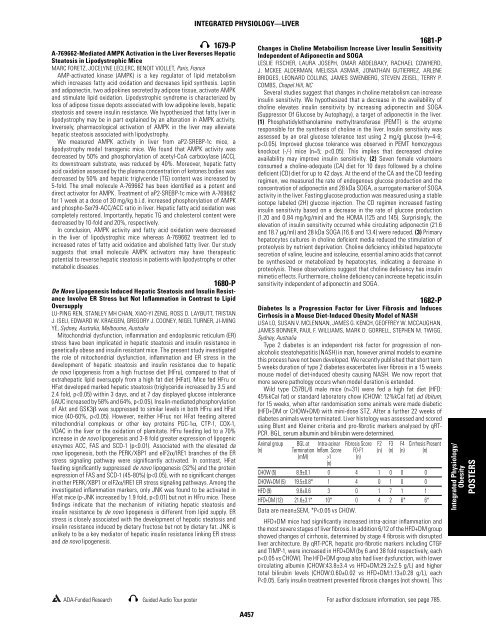2011 ADA Posters 1261-2041.indd - Diabetes
2011 ADA Posters 1261-2041.indd - Diabetes
2011 ADA Posters 1261-2041.indd - Diabetes
Create successful ePaper yourself
Turn your PDF publications into a flip-book with our unique Google optimized e-Paper software.
& 1679-P<br />
A-769662-Mediated AMPK Activation in the Liver Reverses Hepatic<br />
Steatosis in Lipodystrophic Mice<br />
MARC FORETZ, JOCELYNE LECLERC, BENOIT VIOLLET, Paris, France<br />
AMP-activated kinase (AMPK) is a key regulator of lipid metabolism<br />
which increases fatty acid oxidation and decreases lipid synthesis. Leptin<br />
and adiponectin, two adipokines secreted by adipose tissue, activate AMPK<br />
and stimulate lipid oxidation. Lipodystrophic syndrome is characterized by<br />
loss of adipose tissue depots associated with low adipokine levels, hepatic<br />
steatosis and severe insulin resistance. We hypothesized that fatty liver in<br />
lipodystrophy may be in part explained by an alteration in AMPK activity.<br />
Inversely, pharmacological activation of AMPK in the liver may alleviate<br />
hepatic steatosis associated with lipodystrophy.<br />
We measured AMPK activity in liver from aP2-SREBP-1c mice, a<br />
lipodystrophy model transgenic mice. We found that AMPK activity was<br />
decreased by 50% and phosphorylation of acetyl-CoA carboxylase (ACC),<br />
its downstream substrate, was reduced by 40%. Moreover, hepatic fatty<br />
acid oxidation assessed by the plasma concentration of ketones bodies was<br />
decreased by 50% and hepatic triglyceride (TG) content was increased by<br />
5-fold. The small molecule A-769662 has been identifi ed as a potent and<br />
direct activator for AMPK. Treatment of aP2-SREBP-1c mice with A-769662<br />
for 1 week at a dose of 30 mg/kg b.i.d. increased phosphorylation of AMPK<br />
and phospho-Ser79-ACC/ACC ratio in liver. Hepatic fatty acid oxidation was<br />
completely restored. Importantly, hepatic TG and cholesterol content were<br />
decreased by 10-fold and 20%, respectively.<br />
In conclusion, AMPK activity and fatty acid oxidation were decreased<br />
in the liver of lipodystrophic mice whereas A-769662 treatment led to<br />
increased rates of fatty acid oxidation and abolished fatty liver. Our study<br />
suggests that small molecule AMPK activators may have therapeutic<br />
potential to reverse hepatic steatosis in patients with lipodystrophy or other<br />
metabolic diseases.<br />
1680-P<br />
De Novo Lipogenesis Induced Hepatic Steatosis and Insulin Resistance<br />
Involve ER Stress but Not Infl ammation in Contrast to Lipid<br />
Oversupply<br />
LU-PING REN, STANLEY MH CHAN, XIAO-YI ZENG, ROSS D. LAYBUTT, TRISTAN<br />
J. ISELI, EDWARD W. KRAEGEN, GREGORY J. COONEY, NIGEL TURNER, JI-MING<br />
YE, Sydney, Australia, Melbourne, Australia<br />
Mitochondrial dysfunction, infl ammation and endoplasmic reticulum (ER)<br />
stress have been implicated in hepatic steatosis and insulin resistance in<br />
genetically obese and insulin resistant mice. The present study investigated<br />
the role of mitochondrial dysfunction, infl ammation and ER stress in the<br />
development of hepatic steatosis and insulin resistance due to hepatic<br />
de novo lipogenesis from a high fructose diet (HFru), compared to that of<br />
extrahepatic lipid oversupply from a high fat diet (HFat). Mice fed HFru or<br />
HFat developed marked hepatic steatosis (triglyceride increased by 3.5 and<br />
2.4 fold, p
















